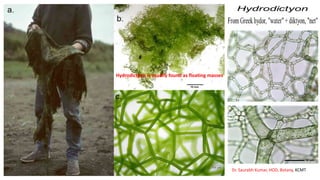Hydrodictyon
•Télécharger en tant que PPTX, PDF•
0 j'aime•3,683 vues
BSc Semester One Algae
Signaler
Partager
Signaler
Partager

Recommandé
Contenu connexe
Tendances
Tendances (20)
Structure, reproduction, life history and systematic position of Lycopodium

Structure, reproduction, life history and systematic position of Lycopodium
Morphology, Structure and Reproduction of Equisetum. 

Morphology, Structure and Reproduction of Equisetum.
Similaire à Hydrodictyon
Similaire à Hydrodictyon (20)
Kingdom Plantae presented by Vrushali Gharat to Mr. Kailash vilegave

Kingdom Plantae presented by Vrushali Gharat to Mr. Kailash vilegave
Dernier
Dernier (20)
Formation of low mass protostars and their circumstellar disks

Formation of low mass protostars and their circumstellar disks
Biopesticide (2).pptx .This slides helps to know the different types of biop...

Biopesticide (2).pptx .This slides helps to know the different types of biop...
Pulmonary drug delivery system M.pharm -2nd sem P'ceutics

Pulmonary drug delivery system M.pharm -2nd sem P'ceutics
All-domain Anomaly Resolution Office U.S. Department of Defense (U) Case: “Eg...

All-domain Anomaly Resolution Office U.S. Department of Defense (U) Case: “Eg...
Stunning ➥8448380779▻ Call Girls In Panchshil Enclave Delhi NCR

Stunning ➥8448380779▻ Call Girls In Panchshil Enclave Delhi NCR
PossibleEoarcheanRecordsoftheGeomagneticFieldPreservedintheIsuaSupracrustalBe...

PossibleEoarcheanRecordsoftheGeomagneticFieldPreservedintheIsuaSupracrustalBe...
Forensic Biology & Its biological significance.pdf

Forensic Biology & Its biological significance.pdf
Chemical Tests; flame test, positive and negative ions test Edexcel Internati...

Chemical Tests; flame test, positive and negative ions test Edexcel Internati...
9654467111 Call Girls In Raj Nagar Delhi Short 1500 Night 6000

9654467111 Call Girls In Raj Nagar Delhi Short 1500 Night 6000
Recombination DNA Technology (Nucleic Acid Hybridization )

Recombination DNA Technology (Nucleic Acid Hybridization )
Disentangling the origin of chemical differences using GHOST

Disentangling the origin of chemical differences using GHOST
Hydrodictyon
- 1. Hydrodictyon is usually found as floating masses Dr. Saurabh Kumar, HOD, Botany, KCMT
- 2. Hydrodictyon, known as the "water net", has large colonies composed of elongate cells linked in a reticulated, net-like pattern in fresh water. Each cell is connected at its end walls to two other cells, forming meshes of five or six cells. The colonies can be as large 4-6 cm wide and 1 m long. The cells are coenocytic and multinucleate. Young cells have a single parietal chloroplast with one pyrenoid, while in older cells the chloroplasts become net-like with multiple pyrenoids. Large vacuoles take up most of the cellular space and push the cytoplasm around the periphery of the cell. A nonmotile coenobium Thallus Structure of Hydrodictyon
- 3. Cell Structure of Hydrodictyon Every cell is long, ovoid, or cylindrical in shape. Its internal structure may be varied into two parts: protoplasm and cell wall. The cell wall is two-layered and is made of cellulose. It encloses the protoplasm. When it is young, the cells are uninucleate, but at maturity level, they become multinucleate (or coenocytic). Cells also contain reticulate chloroplast with several pyrenoids. All of the classic green algal structures, such as mitochondria, ribosomes, and dictyosomes, are present. As the cell gets matured, a central vacuole appears, and the protoplasm will become peripheral.
- 4. Reproduction in Hydrodictyon It is given as three types: Vegetative, asexual, and sexual. Vegetative Reproduction It occurs by fragmentation. Coenobium breaks up into small pieces known as fragments, which have the capability to grow into new colonies. It can be because of the movement of aquatic animals or water currents.
- 5. Asexual Reproduction It occurs by the formation of daughter colonies or the autocolonies. These colonies can be formed by the uninucleate, biflagellate zoospores. Under favorable conditions, every coenocytic cell behaves as a zoosporangium. Its nuclei undergo mitotic divisions to produce numerous nuclei count (7000-20000). Protoplasm gets segmented into a possible number of segments as there are nuclei. Every segment gets surrounded by a small amount of cytoplasm, which is a limiting membrane and develops 2 whiplash-type equal flagella and also represents biflagellate zoospore In Hydrodictyon, a peculiar phenomenon can be noticed. Thus, the zoospores formed are never liberated outside of the parent cell. They remain motile within the restricted region. It means within the cell. They ultimately withdraw their flagella after swimming inside the cell and get themselves arranged into the characteristic pentagonal or hexagonal fashion to form a new net. This new net is known as daughter colony or autocolony. The auto colonies can be liberated by the parent cell wall disintegration. The cell count in the daughter colony is fixed. Further coenobium growth is entire because of an increase in the cell size, but not the cell count.
- 6. Sexual Reproduction It is defined as isogamous. Any coenobium’s vegetative cell can function as gametangium. The biflagellate gametes can be produced by the cleavage of the gametangia- like protoplasm that of zoospores They are produced in large numbers, and they are smaller in size compared to the zoospores. They are individually liberated via a hole in the parent cell wall and swim in the water freely. The gametes are biflagellate and uninucleate. Where hydrodictyon is given as monoecious. The gametes, either from similar or different coenobia after liberation, fuse to form Quadriflagellate zygotes. Soon they will lose their flagella and then settle down. The immobilized zygote type enlarges in size, becomes spherical, and develops a thick wall to form a zygospore. First, it is green in color, but it becomes red color due to the development of a red pigment haematochrome. Stages in Sexual Reproduction in Hydrodictyon
- 7. Germination of Zygospore During winter season the zygospore remains in resting period, and germinate at the onset of spring season. The diploid nucleus divides meiotically to form four haploid nuclei. Each uninucleate segment develops into a biflagellate zoospore. After a short period of motility the zoospores come to rest. Each zoospore or swarmer secretes a thick spiny wall around itself and makes polyhedron. The polyhedron increase in size and its content divide to make 200-300 zoospores. The zoospores arrange themselves in the form of a new daughter colony. After the rupture of polyhedron the young coenobium is released. Life cycle is Haplontic